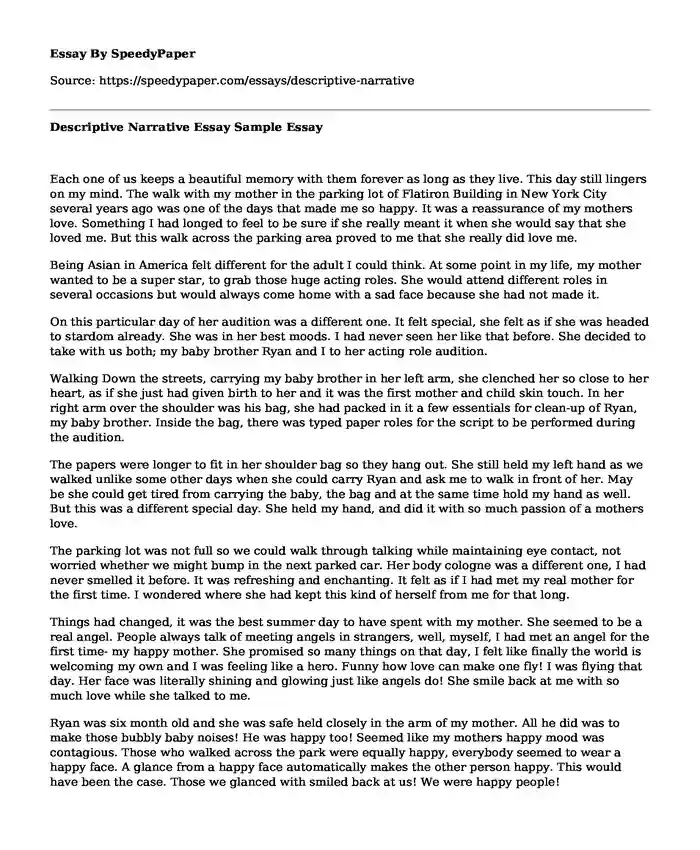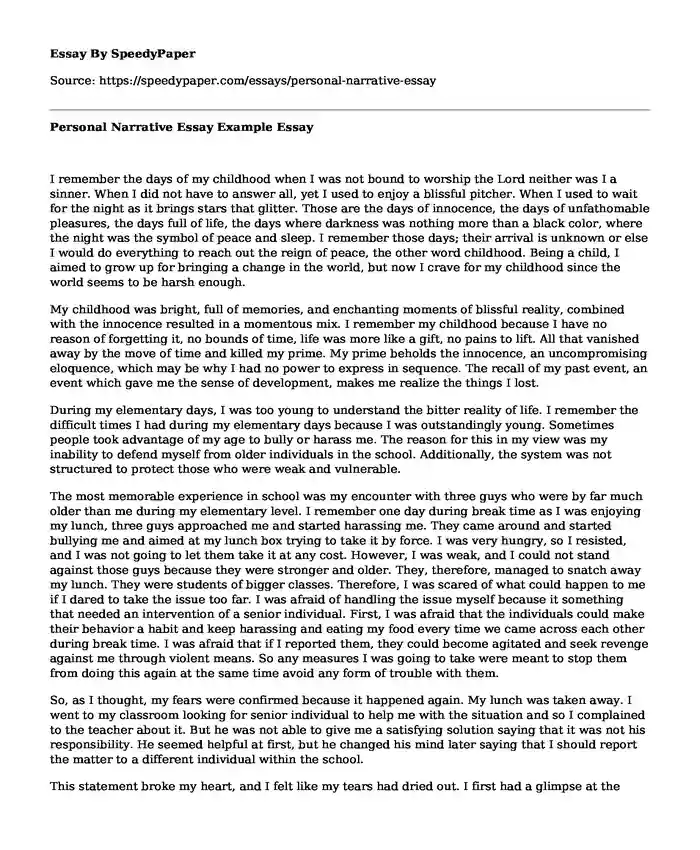
How to write a narrative essay: guide and samples
Table of contents |
When you need to write a narrative essay, it seems like you got your winning ticket. It is probably one of the simplest tasks that your teacher or professor can assign you. There are no strict requirements, the only thing that you need to fulfill is to create an interesting story which will capture the reader's attention from the first sentences. However, before you start writing, you need to select a good topic, and that is the rock on which the most of students split. Some learners opt to hire a knowledgeable writing helper online to pick the most interesting topic and not rack their brains. Getting help from a quick essay writer will help you not only come up with an appealing topic, but will also give you a unique chance to deliver a coherent, consistent and influential paper.
You may have dozens of good ideas in your head, but you can hardly shape any of them into a worthy topic. If you are experiencing such a situation, you may need some good examples of narrative essay topics. That’s why we have prepared seven different lists of topics from simple to more complex ones. Find topics for a narrative essay below and use them for your paper writing.
What is a narrative essay?
A narrative essay is a paper that tells a story. You can think of it as the transcript of the narrator’s words setting scenes in a movie. Short stories can also be considered samples of the narrative writing style.
The biggest problem with writing narrative essays is the maximum word count requirement. So not only do you have to tell an exciting story by keeping the readers engaged and providing a satisfying ending, but you also need to understand the different types of narrative writing to ensure your writing is focused and concise to meet the assignment requirements.Why are such essays important for students?
Narrative essays are critical tools for learning. They boost creativity, hone writing skills, and promote critical thinking. Their power lies in storytelling, an engaging method of sharing information. Students understand their experiences and the world more deeply by exploring narrative essay topics. These essays encourage emotional engagement, making the learning process intriguing and memorable.Further, narrative essays are excellent practice for Speedy essay writing. These assignments demand clear, concise narration, teaching students to communicate effectively within a time constraint. It's a practical skill applicable beyond the classroom and useful in personal and professional life.
Why use our narrative essay example collection?
Before you craft a compelling narrative essay, you need to get the feeling for the narrative writing style and the tools and techniques used to tell stories with as few words as possible. To help you get into the right mindset, we’ve created a collection of narrative essay samples and hand-picked a few of the best examples to get you started.
Please remember not to submit any example of a narrative essay for grading under your name. Instead, get professional writers to craft a story for you. It’s a fast and easy way to secure a good grade.

How to write a narrative essay
We won’t fit everything we know about how to write a narrative essay in this post, so we’ll focus on the most problematic aspects students often struggle with.
Choose a narrative essay topic
To write a narrative essay, you need an exciting idea. First, analyze the assignment prompt and consider the keywords you find there. For example, if it includes words like “describe” or “detail”, your narrative should be descriptive; therefore, you need to pick a topic that would require a detailed depiction of a person, place, or item. Next, scroll down to our list of 100+ topics for narrative essays, choose the fitting category, and make the most of the ideas you find.
Tip from SpeedyPaper:
Think of a lesson or moral of your narrative essay and build your story around it, discarding details and subplots that don’t add to the main idea.
Create a narrative essay outline
If you don’t know how to start a narrative essay, an outline is a must. Jot down the pivotal points of your story, main characters, details, and pieces of dialogue you wish to include. Then, try to throw out the first third of your outline and consider if it makes your narrative essay more dynamic. If the story doesn’t lose much without those few opening paragraphs, leave them out and focus on building conflict and providing a satisfying resolution.
Tip from SpeedyPaper:
Think of your narrative essay as a movie script and follow the three-act structure: introduce the main characters, build conflict up to the culmination, and provide a resolution.
Remember to write in first-person
We recommend you consult your professor on how to outline and format a narrative essay. Although first-person writing is unsuitable for most academic assignments, most narrative pieces involve personal stories, so using the first-person is natural. Still, it’s best to ask your instructor if you’re unsure if it’s appropriate.
Let your creativity shine
Unlike most assignments, narrative essays rarely require research and references. Instead, the goal is to teach you to tell compelling stories based on your experience. It’s a valuable skill that requires practice, so don’t be shy about trying new things, techniques, literary devices, or structures. Think of a narrative essay as a way to stretch your writing muscles in ways no other academic assignment will allow you. So be bold, but remember to stick to the prompt requirements.
Tip from SpeedyPaper:
Keep your use of literary devices in the narrative essay consistent: do not mix metaphors or overuse epithets and similes. Your story must remain readable.
Make the most of the post-writing routine
Just because you can be as creative as you wish doesn’t mean your narrative essay should be sloppy. Professors will still detract points for mistakes and poor formatting. So give yourself enough time to go through the paper before turning it in to:
- Test your narrative and ensure the story flows smoothly and logically and is easy to follow.
- Read it out loud and correct any sentences that are a mouthful and otherwise hard to read.
- Use a professional spellchecker, like Grammarly, to catch any mistakes, typos, and missing commas.
- Bring out the formatting style guide and make sure the typeface, size, line spacing, margins, and headings are all properly formatted.
If you’re unsure about your narrative essays requirements, ask your professor for additional instructions or a rubric.
Tip from SpeedyPaper:
Watch your use of tenses. Ideally, you should stick to the past or the present without constant shifts to keep the readers engaged and help them follow your narrative essay.
Conclusion
Hopefully, our guide, tips and samples will help you deal with writing of your narrative essay. Feel free to use any resources we provide as you see fit. And if you need assistance with other assignments, check out our recent blog posts, like a detailed guide on how to write a cause-and-effect essay.But if the time is running out and you’re no closer to completing your assignment, contact our team. Share your writing problems, and we’ll find the best solution for you, whether you have two days or two weeks before the deadline.
Comments (6)
Gary Feb 20, 2025
How do I ensure that my narrative essay has a clear moral or lesson without making it seem forced or unnatural?
Kimberly Feb 20, 2025
What role does conflict play in a narrative essay, and how can I effectively build it in my story?

Jennifer White Feb 20, 2025
Conflict drives the story by creating tension and stakes. Introduce obstacles that challenge the protagonist’s goal, using both internal (emotional struggles) and external (events, other characters) conflicts.
Nicholas Feb 20, 2025
How should I balance creativity with clarity to ensure my narrative essay remains readable and structured?

Jennifer White Feb 20, 2025
Use vivid descriptions and creative storytelling while maintaining logical flow. Keep sentences concise and ensure transitions guide the reader smoothly through the narrative.
Taylor Feb 20, 2025
How can I improve the pacing of my narrative to make it more engaging for the reader?

Jennifer White Feb 20, 2025
Vary sentence length and structure to control rhythm. Speed up action scenes with short, sharp sentences and slow down emotional moments with detailed descriptions and introspection.
Susan Feb 20, 2025
What are the ethical considerations of using real-life experiences in a narrative essay?

Jennifer White Feb 20, 2025
Obtain consent when writing about others, anonymize sensitive details, and be mindful of potential harm. Respect privacy and avoid misrepresentation.
Benjamin Feb 20, 2025
How does the three-act structure help in organizing a narrative essay, and are there other structures that work well?

Jennifer White Feb 20, 2025
The three-act structure (setup, confrontation, resolution) ensures coherence. Alternatives include the Hero’s Journey (ideal for personal transformation) or In Medias Res (starting mid-action for an engaging hook).





Jennifer White Feb 20, 2025
Show rather than tell—let the events and character growth subtly reveal the lesson. Use dialogue, actions, and consequences to illustrate the theme rather than stating it outright.